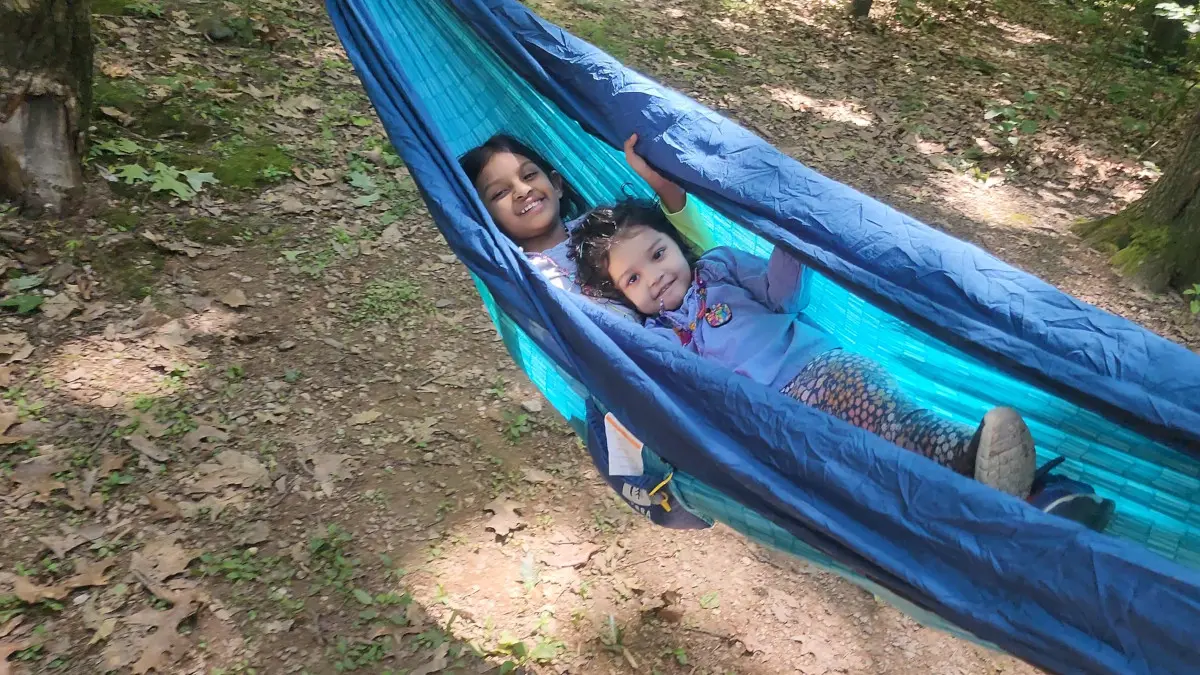Camping is a fantastic way to connect with nature, bond with your family, and create lasting memories. While camping with little children might seem daunting, with some preparation and the right mindset, it can be a rewarding and enjoyable experience for parents and kids. When we moved from India to the USA, camping was one of the most desired things we wanted to do, and why not, afterall the USA is about the great outdoors! However, planning our first camping trip took some effort and help from an American friend who had experience. I have compiled this guide to walk you through the essential steps and tips for a successful tent camping trip with young children. By tent camping, I mean your drive to a managed campground and set up a tent to camp, also called car camping. Any gear recommendation in this post is for decent budget versions to help you get outdoors and not get discouraged by the prohibitive cost of premium gear. However, if you can afford it, then the sky is the limit, and I recommend reaching out to an outdoor fitter store like REI, DICKs’ etc.
For beginners, check out this article on Camping101.
Plan Your Trip
Planning is crucial to ensure a smooth camping experience with little ones. Here’s how to approach it:
- Trip Duration and Booking: Consider the length of your camping trip. For beginners with young children, it’s often best to start with a shorter trip, perhaps a one-night getaway over the weekend, to gauge your family’s comfort level and address potential challenges – that’s how we started. Start looking for campgrounds well in advance to verify they fulfill all your family’s requirements. Most managed campgrounds require an advanced booking, and popular destinations quickly fill up.
- Weather Considerations: Check the weather forecast for the duration of your trip. It will help you pack appropriate clothing and gear to keep everyone comfortable and safe, especially for sudden weather changes in mountainous or coastal areas.
- Choose the Right Campground: Selecting the appropriate campground sets the foundation for a positive camping experience with young children. Here are some aspects to consider:
- Family-Friendly Amenities: Look for campgrounds that offer family-friendly amenities such as clean and well-maintained restrooms, access to potable water, and designated family camping areas. These facilities can significantly simplify your camping experience and ensure your children’s comfort. I have little kids; therefore, I always book a campsite closer to the bathroom complex.
- Activities for Kids: Check if the campground offers activities suitable for children, such as nature trails/centers, playgrounds, or swimming areas. These activities will keep your little ones entertained and excited about the camping trip.
- Proximity to Home: For your first camping trip with young children, consider choosing a campground near home. This proximity can provide reassurance, making it easier to address any unexpected situations or needs that may arise.
Pack Thoughtfully
Packing efficiently and thoughtfully is critical to ensuring your family’s comfort during the camping trip. Here’s what to include:
- Tent: Opt for a spacious tent that accommodates your family comfortably. It’s tempting to buy a large tent with multiple rooms or dividers to create separate sleeping spaces for children and adults. However, though excellent, they are expensive and not always necessary. A budget tent, for example, Coleman Sundome, could be sufficient while starting. Practice setting it up at home to become familiar with the process.
Warning: Budget tents do not hold well in heavy rain. So consider camping on dry days or buy a tarp for an extra layer over your tent if needed.
- Sleeping Gear: Each family member should have either a sleeping bag or a blanket, a sleeping pad, and a pillow. For our little ones, we opt for blankets over sleeping bags. Familiar bedding, like their favorite stuffed animals or blanky, can help children feel secure and at ease.
- Clothing: Pack clothing suitable for the expected weather conditions, including layers for cooler evenings. Bring extra clothes for children, as they can get messy while exploring. Waterproof and breathable clothing is beneficial in wet or rainy weather.
- Food and Cooking Supplies: Plan simple, kid-friendly meals that are easy to prepare at the campsite. Pack a portable camp stove, cookware, utensils, disposable plates, and cutlery for convenience. Always bring enough water for everyone, even if the campground has potable water outlets. And don’t forget to bring a cooler with ice packs to store perishable food items.
- First Aid Kit and Prescription Medication: Assemble a kit that may include essential items like adhesive bandages, gauze pads, antiseptic wipes/creams, pain relievers, and personal prescription medications. Additionally, items such as a CAT tourniquet, splint materials, blister treatment, and compact emergency blankets are invaluable for addressing a variety of potential injuries. However, don’t overwhelm yourself by thinking about all the possible scenarios where things can go wrong. If you are camping in a managed campground, you will be just a phone call away from help.
- Entertainment: Bring games, books, and activities to keep children engaged during downtime (rain). Consider nature guides, binoculars/bugnoculars, or a magnifying glass for educational exploration.
Practice Camping Skills
Before embarking on your camping trip, familiarize your children with essential camping skills:
- Setting Up the Tent: Pitch the tent in your backyard or a nearby park before the trip. Involve your children to teach them how to assemble and disassemble the tent. This hands-on experience will boost their confidence and help them feel more at home at the campsite. My kids love hammering the tent stakes and holding ten poles while the grown-ups lift the tent up.
- Building a Campfire: If campfires are allowed at your campground, educate your children about how to build a campfire. Little children should not be allowed to handle a fire source, but they love gathering dry leaves and twigs for tinder and kindling material. Explain the importance of staying safe from the fire, never leaving it unattended, and extinguishing it completely when finished. Check out this blog post to learn more about how to build and maintain a campfire.
- Camping Etiquette: Teach your children about camping etiquette, such as respecting nature by not picking flowers, observing the wildlife from a safe distance and not feeding or disturbing animals, staying on designated trails to minimize their impact on fragile ecosystems, note leaving litter behind (leave no trace principles), and following campground rules, including observing the quiet hours. Explain the significance of protecting natural areas for future generations to enjoy. Instilling these values early will help raise responsible campers.
Safety
Safety should always be a top priority when camping with children. Here are some essential safety considerations:
- Supervision: Closely supervise your children, especially in potentially hazardous areas near the campfire or water sources (lake, sea/bay shore, or ponds). Keep a watchful eye to prevent accidents and address any concerns promptly.
- Bug Protection: Protect your children from insect bites by using appropriate insect repellent and dressing them in long sleeves and pants, particularly during dawn and dusk when bugs are most active. For insect repellents, always check the strengths that can be used with children before leaving home. We prefer picaridin-based insect repellent.
- Sun Protection: Apply sunscreen with a high SPF to shield your children from harmful UV rays. Ensure they wear hats and sunglasses for additional sun protection, especially on hot, sunny days.
- Campfire Safety: If you have a campfire, create a safe zone around it using rocks or a designated fire ring. Educate your children about the dangers of fire, and keep a bucket of water or a fire extinguisher nearby for emergencies.
Be Flexible
Flexibility is essential when camping with children and often requires putting their interest and comfort before yours, as camping with a cranky toddler is no fun for anyone. Embrace the slower pace and be prepared for unexpected changes to your itinerary. Here’s how to do it:
- Adapt to Children’s Interests: If your child shows interest in a particular activity, like exploring a nearby stream or watching wildlife, allow them the time to do so. These spontaneous moments often lead to the most cherished memories.
- Plan Rest Periods: Young children may need naps or rest breaks during the day. Plan for downtime in your camping schedule to ensure everyone stays well-rested and in good spirits.
- Stay Open to Change: Weather conditions can change, and children’s moods can be unpredictable. Be prepared to adjust your plans, whether seeking shelter from rain, finding indoor activities, or changing mealtimes to accommodate hungry little ones.
Conclusion
Tent camping with little children can be an enriching experience that fosters a love for the outdoors and creates lasting family memories. By carefully selecting a family-friendly campground, planning thoughtfully, prioritizing safety, and embracing flexibility, you can embark on a successful camping adventure that you and your children will cherish for years. Remember that every camping trip is a unique adventure, and practice will make it easier and even more enjoyable for your family. So, get out there, breathe in the fresh air, and let the beauty of nature inspire your family’s love for the great outdoors.


Leave a Reply
You must be logged in to post a comment.